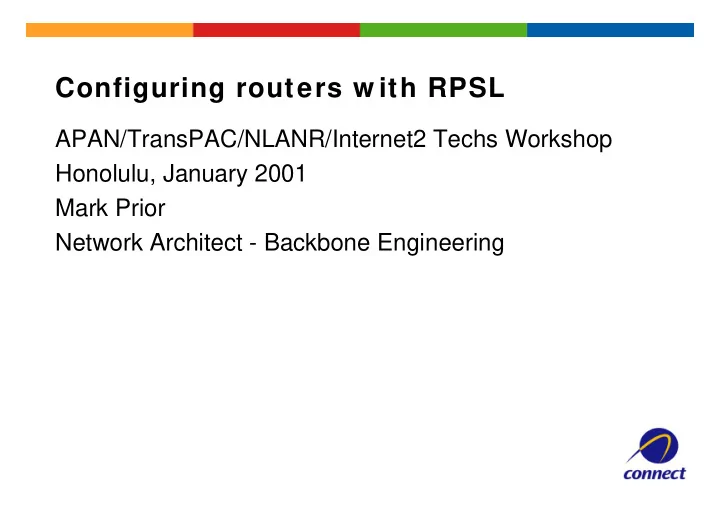

Configuring routers w ith RPSL APAN/TransPAC/NLANR/Internet2 Techs Workshop Honolulu, January 2001 Mark Prior Network Architect - Backbone Engineering
Who am I? Network Architect for Tier 1 ISP in Australia Use RPSL to manage our routing policy and configure routers Member of the RPS working group at IETF
Agenda Overview Routing Policy Creating policy in RPSL Using RtConfig to generate policy Questions anytime!
What is Routing Policy • Public description of the relationship between external BGP peers • Can also describe internal BGP peer relationship • Usually registered at an IRR (Internet Routing Registry) such as RADB or RIPE
Routing Policy • Who are my BGP peers • What routes are – Originated by a peer – Imported from each peer – Exported to each peer – Preferred when multiple routes exist • What to do if no route exists
What is RPSL? • Object oriented language • Structured whois objects • Refinement of RIPE 181 (and it’s predecessors) based on operational experience • Describes things interesting to routing policy – Prefixes – AS Numbers – Relationships between BGP peers – Management responsibility FOR MORE INFO... RFC 2622 - “Routing Policy Specification Language (RPSL)”
How to begin • Need to identify which IRR to use – May want to run your own for control • Need to decide what degree of filtering is desired – Prefix filters – AS path filters – Both! • Register a maintainer object at chosen IRR – Usually a “manual” process and could be multi-stage if PGP key authentication required
Maintainer Objects • Maintainer objects used for authentication • Multiple authentication methods – NONE, MAIL-FROM, CRYPT-PW, PGPKEY mntner: [mandatory] [single] [primary/look-up key] descr: [mandatory] [multiple] admin-c: [mandatory] [multiple] [inverse key] tech-c: [optional] [multiple] [inverse key] upd-to: [mandatory] [multiple] [inverse key] mnt-nfy: [optional] [multiple] [inverse key] auth: [mandatory] [multiple] remarks: [optional] [multiple] notify: [optional] [multiple] [inverse key] mnt-by: [mandatory] [multiple] [inverse key] changed: [mandatory] [multiple] source: [mandatory] [single]
Maintainer Object Example mntner: MAINT-AS2764 descr: Maintainer for AS 2764 admin-c: MP151 upd-to: routing@connect.com.au mnt-nfy: routing@connect.com.au auth: PGPKEY-81E92D91 auth: PGPKEY-562C2749 auth: PGPKEY-8C1EEB21 mnt-by: MAINT-AS2764 changed: mrp@connect.com.au 20000725 source: RADB
key-cert Object Example key-cert: PGPKEY-562C2749 method: PGP owner: Connect Registry System <dbmon@connect.com.au> owner: Connect Registry System <routing@connect.com.au> fingerpr: A9 B7 B5 08 E5 37 07 B5 60 84 7B D3 E3 69 AA 2B certif: -----BEGIN PGP PUBLIC KEY BLOCK----- Version: 2.6.3ia + mQCNAzUDNN0AAAEEALGWO23hXxzuvjrn1MvCHrEWMeV1QeHxQS4EqQYwQPEAMaGn 8KXyGe3Bz/2H71kgcrcBJByWhXqr1pxaJKzJyqPbrZDIXlyg63T35deCm2mSVVnz G2hRe61j2cQSO4TN/3p5QujzXSBS6ZT8BrAb6Yp/5amjEJVxNhCFFaxWLCdJAAUR tDBDb25uZWN0IFJlZ2lzdHJ5IFN5c3RlbSA8cm91dGluZ0Bjb25uZWN0LmNvbS5h dT6JAJUDBRA1AzZMZTbj8YHpLZEBAfv9BADmIs6Nw+mnbJy4U+RVUurjQw9L615v Ig9p6OhSikLMn7QffjYCJacYlZoN1uaB0sc1yzd4vgzDHFRm30vt+3XPBRQPQgek jv4CG7iVJaQavojxgXdoZBaCgUfTJKLzBa3M20QlwAdx48oWOgcmeoEMUTmfaw61 0DJb6k+i45hF2YkAlQMFEDUDNN4QhRWsViwnSQEBRVID/jRQYNGDD69Zj7ab3hlR R4IfpTdRmj3j0moL9ho6JFrv/Um6f35Jjpu5LHW2LVP2ielCd91HVCopv/L0z344 PH8nT4jJdmVcj4dHMIpqQDm3pt2t8h29lY27In1FfmmHZvSolug6QYwg5b25mWDv +cr5f0noJIGLxItua8CtrzPFtC5Db25uZWN0IFJlZ2lzdHJ5IFN5c3RlbSA8ZGJt b25AY29ubmVjdC5jb20uYXU+iQCVAwUQNQM1lBCFFaxWLCdJAQF8KAP/XhrCbMMx 4y2IEk3rq6kfyapa+j1F+NUeEV7hdMmm60gSu+yv3cMwxgdwopmLlzoU0huf71Ad 4NPU4SviWfQU6C77OvlSv4NbNqzUCSH7Smj0Q31J2bQmLlUXRK0GoroRmjbbgqKf CMkENl7v1acbvg6oNUPvfqVR2OBMkbdaei4= =Keyg -----END PGP PUBLIC KEY BLOCK----- mnt-by: MAINT-AS2764 changed: mrp@connect.com.au 20000709 source: RADB
Route Object • Use CIDR length format • Specifies origin AS for a route • Can indicate membership of a route set route: [mandatory] [single] [primary/look-up key] descr: [mandatory] [multiple] origin: [mandatory] [single] [primary/inverse key] withdrawn: [optional] [single] member-of: [optional] [single] [inverse key] inject: [optional] [multiple] components: [optional] [single] aggr-bndry: [optional] [single] [inverse key] aggr-mtd: [optional] [single] export-comps: [optional] [single] holes: [optional] [single] remarks: [optional] [multiple] cross-nfy: [optional] [multiple] [inverse key] cross-mnt: [optional] [multiple] [inverse key] notify: [optional] [multiple] [inverse key] mnt-by: [mandatory] [multiple] [inverse key] changed: [mandatory] [multiple] source: [mandatory] [single]
Route Object Examples route: 203.63.0.0/16 descr: connect.com.au pty ltd origin: AS2764 notify: routing@connect.com.au mnt-by: MAINT-AS2764 changed: mrp@connect.com.au 19971027 source: RADB route: 203.102.39.0/24 descr: Web One (13480) origin: AS2764 member-of: AS2764:RS-NEWSKIES notify: routing@connect.com.au mnt-by: CONNECT-AU changed: mrp@connect.com.au 20001211 source: CCAIR
AS Set • Collect together Autonomous Systems with shared properties • Can be used in policy in place of AS • RPSL has hierarchical names as-set: [mandatory] [single] [primary/look-up key] descr: [mandatory] [multiple] members: [optional] [single] mbrs-by-ref: [optional] [single] remarks: [optional] [multiple] tech-c: [mandatory] [multiple] [inverse key] admin-c: [mandatory] [multiple] [inverse key] notify: [optional] [multiple] [inverse key] mnt-by: [mandatory] [multiple] [inverse key] changed: [mandatory] [multiple] source: [mandatory] [single]
AS Set Object Examples as-set: AS2764:AS-CUSTOMERS:AS3409 descr: connect.com.au AS set members: AS7632, AS9324 remarks: Autonomous systems that transit through AS3409 admin-c: CC89 tech-c: MP151 mnt-by: MAINT-AS2764 changed: mrp@connect.com.au 20001214 source: RADB
Route Set • Collects routes together with similar properties route-set: [mandatory] [single] [primary/look-up key] descr: [mandatory] [multiple] members: [optional] [single] mbrs-by-ref: [optional] [single] remarks: [optional] [multiple] tech-c: [mandatory] [multiple] [inverse key] admin-c: [mandatory] [multiple] [inverse key] notify: [optional] [multiple] [inverse key] mnt-by: [mandatory] [multiple] [inverse key] changed: [mandatory] [multiple] source: [mandatory] [single]
Route Set Object Example route-set: AS2764:RS-PROVIDER descr: Connect's provider blocks member 202.21.8.0/21, 203.8.176.0/21, 203.63.0.0/16, 210.8.0.0/14 admin-c CC89 tech-c: MP151 notify: routing@connect.com.au mnt-by: MAINT-AS2764 changed: mrp@connect.com.au 20010118 source: RADB route-set: AS2764:RS-NEWSKIES descr: Routes announced across NewSkies satellite link mbrs-by-ref: CONNECT-AU tech-c: MP151 admin-c: CC89 notify: routing@connect.com.au mnt-by: CONNECT-AU changed: mrp@connect.com.au 20010112 source: CCAIR
Autonomous System Object • Routing Policy Description object • Most important components are – import – export • These define the incoming and outgoing routing announcement relationships
Autonomous System Object (cont) aut-num: [mandatory] [single] [primary/look-up key] as-name: [mandatory] [single] descr: [mandatory] [multiple] member-of: [optional] [single] [inverse key] import: [optional] [multiple] [inverse key] export: [optional] [multiple] [inverse key] default: [optional] [multiple] [inverse key] admin-c: [mandatory] [multiple] [inverse key] tech-c: [mandatory] [multiple] [inverse key] remarks: [optional] [multiple] cross-nfy: [optional] [multiple] [inverse key] cross-mnt: [optional] [multiple] [inverse key] notify: [optional] [multiple] [inverse key] mnt-by: [mandatory] [multiple] [inverse key] changed: [mandatory] [multiple] source: [mandatory] [single]
Simple “Documentation” Policy • The simplest policy is strict customer/provider relationship – Customer accepts everything the provider sends – Customer sends its routes to provider aut-num: AS2 as-name: EXAMPLE-NET descr: RPSL Example import: from AS1 accept ANY export: to AS1 announce AS2 admin-c: ADMINISTRATION tech-c: OPERATIONS mnt-by: MAINT-AS2 changed: noc@example.net 20010101 source: TEST
Recommend
More recommend